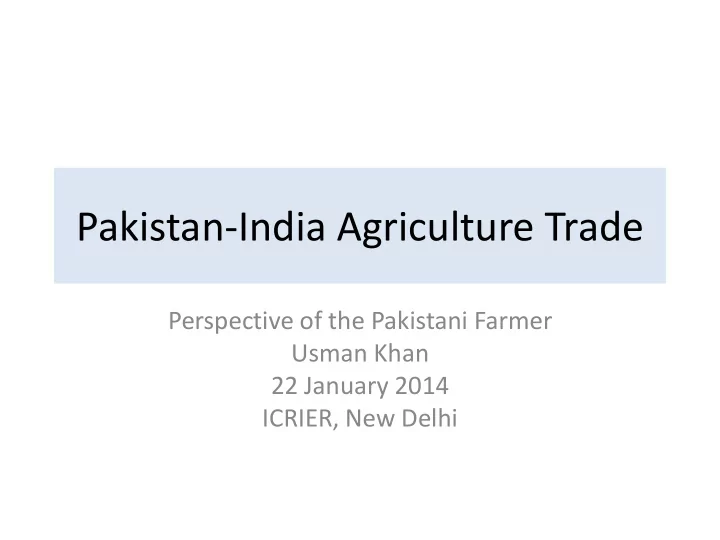

Pakistan-India Agriculture Trade Perspective of the Pakistani Farmer Usman Khan 22 January 2014 ICRIER, New Delhi
Outline • Pakistan – India: Agriculture Sector • Current Pakistan-India Trade in Agriculture • Main Issues in Opening-up Trade – Threat: Imports of Subsidized Products – Limited Export Potential: Restricted Market Access • Other Issues
Pakistan – India: Agriculture Sector
Comparison in Size • Pakistan – 21.4% contribution to GDP in 2012-13 (PKR 5,474 billion) – Employs over 45 % of the country’s labour force • Supports 60% of the rural population – Exports of agricultural products over PKR 250 billion • India – 14.1% contribution to GDP in 2012-13 (PKR 24, 431 billion) – Employs over 58% of the country’s labour force • Indian agriculture sector around 5x as large as Pakistan – Exports of agricultural products over PKR 3,665 billion
Growth Dynamics Source: WDI Data Bank
Key Commodities of Pakistan Source: FAOSTAT
Key Commodities of India Source: FAOSTAT
Pakistan- India: Trade Patterns in Agriculture
Current Pakistan-India Trade in Agriculture
Total Trade between Pakistan & India Source: UNComtrade Dataset
Pakistan-India: Current Agriculture Trade (US$ Mn)
Fastest Growing Agri-Exports of Pakistan to India (%): 2007-11
Fastest Growing Agri-Imports of Pakistan from India (%): 2007-11
Potential Products for Export by Pakistan to India
Main Issues in Opening-up Trade Threat: Importation of Subsidized Products
India: Main Subsidy Expenditures (INR. Crores)
Impact of Subsidy on Primary Costs (PKR, 2010-11) Sources: - NEPRA, Pakistan - State Bank of Pakistan - Ministry of Chemicals and Fertilizers, India
Comparison of Wholesale Prices of Key Products PKR/Qtl (2010-11) * Denotes MSP in India rather than wholesale price Sources: -Pakistan Bureau of Statistics -Ministry of Consumer Affairs, Food and Public Distribution, India
Limited Threat to Key Crops Sources: World Bank , FAOSTAT, UNComtrade
Fresh vegetables and perishables sector • SRO in March 2012 allowed duty free imports – Purpose was to control food inflation • Limited success in doing that – However, Tunnel Farming reduced from 55,000 acres to 30,000 acres – In 2012 around US $120 Million worth of tomatoes were imported • Captured markets from Lahore up-to Multan • This has already happened so not related to MFN – Switch from positive to negative list
Main Issues in Opening-up Trade Limited Export Potential: Restrictive Market Access
India: Restrictiveness is High Source: Overall Trade Restrictiveness Index (OTRI) calculations, World Bank
India’s Bound & Applied Agriculture Tariffs - 2010 Applied Ad Item Bound Rate valorem Rate Wheat 100 0 Paddy 80 80 Rice (milled/semi-milled) 70 70 Cereals Corn 70 50 Wheat Flour 150 30 Sorghum 80 80 Other Cereals (rye, barley) 100 0 Pulses 100 0 Oilseeds 100 30 Oil cakes 100 15 300 0 Palm/Groundnut/Safflower/Sunflower/Coconut Crude Vegetable Oils Rapeseed 75 0 Soybean 45 0 Soybean 45 7.5 Refined Edible Oils 300 7.5 RBD Palmolein/Palm/Safflower/Groundnut/Coconut Rapeseed 75 7.5 Sugar 150 0 Milk 100 30 Dairy Products Butter/Cheese 40 30 Milk Powder 60 60 Chicken leg 150 100 Poultry and Fish Whole chicken 100 30 Fish unbound 30 Apples 50 50 Strawberries 100 30 Fruit and Vegetable Onions 100 5 Potato 150 30 Frozen Vegetables 55 30
Non-Tariff Barriers • QPR Policy 2003 allows all fresh fruits & vegetables to be importable into India – SPS and quarantine issues on ground exist • Business Visas for Punjab (Not Implemented) – Traders / Growers have the cheapest market through Amritsar – if visas are not given trade can never pick up.
Other Issues
Other Issues • Weak negotiation strategy by Pakistan – Should include direct stakeholders in all negotiations – Improve analytical research capacity • Water is a big issue for Pakistan – Dialogue on Indus Water Treaty • Energy shortages in Pakistan
Other Issues • Vegetable sector needs protection against the onslaught from India after SRO in 2012 – India has high yield due to excessive use of subsidized fertilizer – enforce and ensure compliance in arsenic level in vegetables from India • Poor governance in agriculture sector – Seed quality and adulterated fertilizer sales must be heavily penalized • India restricts exports from Pakistan of key products such as citrus, mango, fish, potatoes through high bound tariffs, NTBs and sensitive lists – Negotiations should assist in removing these barriers or; – Pakistan should work to increase its trade restrictiveness via effective NTBs
A Separate Agreement for Agriculture? • Consideration of separate Agreement for agriculture came from stakeholder forum • Trade in agricultural goods negotiated separately in the WTO and in NAFTA – WTO : Agriculture trade is subject to a separate Agreement on Agriculture, designed to protect the heavy agricultural subsidies and protectionist tariffs of the EU, US and Japan – NAFTA : Agriculture was the only subject negotiated separately and bilaterally between each NAFTA member, with 3 distinct agreements
A Separate Agreement for Agriculture? • Bilateral trade in agricultural goods between India and Pakistan could also be negotiated separately – Permitted under the WTO framework, because of exception for FTAs and “special arrangements” language in GATT Art XIV.7 – SAFTA mentions “goods” but not “agricultural goods”. Thus, it could be interpreted to not apply to agriculture as that has been the precedent – Applying the NAFTA model, there is a provision in SAFTA for separate protocols, and each SAFTA member could negotiate a bilateral protocol on agriculture
THANK YOU
Recommend
More recommend